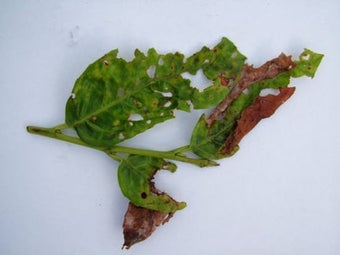
Quick facts
Common name - Bacterial canker
Scientific name - Pseudomonas syringae pv. morsprunorum and P. syringae pv. syringae
Plants affected - Prunus species
Main symptoms - Sunken, dead patches of bark and small holes in leaves
Caused by - Bacteria
Timing - Cankers form in mid-spring, shotholes on foliage from early summer
What is bacterial canker?
Bacterial canker is a disease caused by two closely related bacteria that infect the stems and leaves of plums, cherries and related Prunus species.
Cankers begin to form in mid-spring and soon afterwards shoots may die back. Shotholes appear on foliage from early summer.
Symptoms
You may see the following symptoms:
- On stems and spurs: Sunken, dead areas of develop in spring and early summer, often accompanied by a gummy ooze. If the infection spreads all round the branch it will die rapidly. However, it should be noted that gum production (gummosis) from the bark of Prunus species is actually quite common, and in the absence of dead, sunken bark is likely to have resulted from causes other than bacterial canker, for example physical damage or environmental stresses
- On emerging shoots: Shoots may either fail to emerge, or start to grow normally in spring before dying back rapidly. In severe cases this may affect a large percentage of shoots on a tree. Note that shoot dieback can also be caused by the fungal disease blossom wilt
- On leaves: Small brown spots appear, which are often round and eventually fall out to leave holes – as if the leaf had been hit by shotgun pellets, leading to the popular name of ‘shothole’
N.B. Many trees affected by the disease will exhibit the leaf and shoot symptoms described above without ever developing damaging cankers on the trunk or main branches. The extent of the leaf and shoot symptoms will vary from year to year, depending on weather conditions. They can sometimes result in a sparse-looking crown in wet years that are favourable for the disease, although a tree affected in this way will frequently then show much less damage during drier growing seasons.
Control
Non-chemical control
Where possible, carry out all pruning in July or August when tissues are most resistant. This is also the best time to prune in order to minimise the risk of infection by spores of the fungus causing silver leaf disease. Cut out all cankered areas, pruning back to healthy wood and painting promptly with a wound paint to protect the wound from re-infection. Details of wound paint products can be found in the 'Fungicides for gardeners' document below. Burn or landfill the prunings.
The cherries ‘Merton Glory’, ‘Merton Premier’, ‘Merla’ and ‘Merpet’ and the plums ‘Marjorie’s Seedling’ and ‘Warwickshire Drooper’ have some resistance.
Chemical control
There are no fungicide sprays available to amateur gardeners for the control of bacterial canker.
Download
Fungicides for home gardeners (Adobe Acrobat pdf document outlining fungicides available to gardeners)
Links
Biology
The bacteria Pseudomonas syringae pv. morsprunorum and P. syringae pv. syringae are members of a large genus of plant-pathogenic bacteria. Several others occur in the UK but, generally speaking, bacterial diseases of plants are more important in warmer climates. However, bacterial canker of Prunus is a serious disease and although more often confined to smaller branches, can sometimes kill larger branches or whole trees.
The species P. syringae exists as a large number of pathovars (abbreviated to pv.), so-called because although all look the same, they have different, specific hosts. The pathovar morsprunorum is restricted to Prunus species, whereas pv. syringae has a much wider host range, but both cause similar symptoms on Prunus.
The bacteria exist as surface dwellers (epiphytes) on leaves and, during wet weather in spring or early summer, can enter through the leaf pores ( ), causing infections to develop in the young leaves. As the leaf matures these infections cease to expand and are revealed as small patches of dead tissue. As the leaf expands fully, the live tissues pull away from the dead patch, which drops out, leaving a ‘shothole’.
Cankers develop when the bacterial cells gain entry through wounds or leaf scars at the time of leaf fall. Cankers remain more or less through summer, when tissues are resistant, and during autumn and winter when temperatures are low. In spring, the infections spread rapidly, killing the .
New disease alert: The bacterium Xanthomonas arboricola pv. pruni also affects Prunus species, in particular apricot, peach and plum but also cherry laurel (Prunus laurocerasus). The disease is not established in the UK but has been intercepted on imported plants of cherry laurel. Symptoms include shothole, fruit and leaf spotting (often with a distinct yellow halo), stem cankers and severe defoliation. Any suspected cases on nursery stock or newly-planted plants should be reported to the relevant plant health authority, whose contact details can be found on the UK Plant Health Information Portal.







